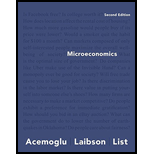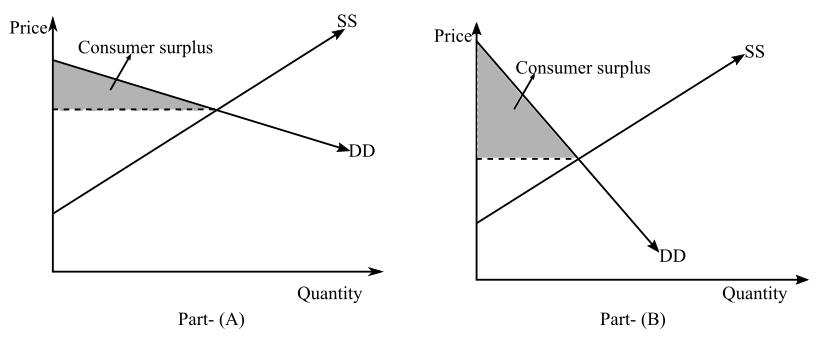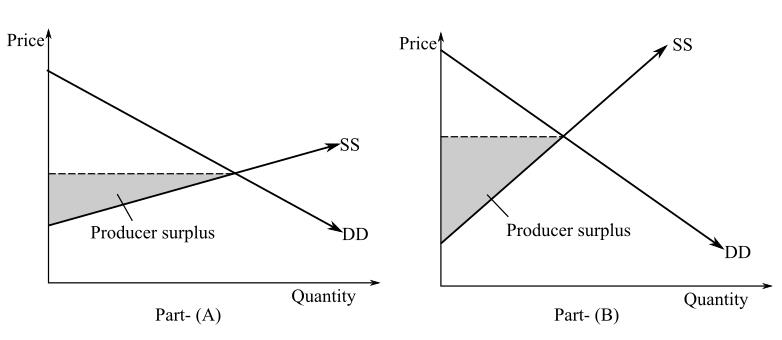
The effect of change in the
Explanation of Solution
The Elasticity of
Social surplus is the sum total of both

In part (a) of the above diagram, DD is the demand and elastic demand curve, SS is the supply curve, and the
So, if the elasticity of demand is higher, consumer surplus will be lower as what a consumer is willing to pay becomes equal to what they actually pay.
Thus, the social surplus will also be lower as it consists of consumer surplus.
Similarly,

DD is the demand curve, SS is the elastic supply curve and the equilibrium price is where DD and SS intersect. Producer surplus is calculated between the price and above the supply curve, which means the higher the elasticity of supply, the lower is the producer surplus which will decrease social surplus. As the elasticity of supply increases, producer surplus also increases as shown in part ( b ) of the diagram, which will increase social surplus.
Want to see more full solutions like this?
Chapter 7 Solutions
Microeconomics (2nd Edition) (Pearson Series in Economics)
- 2. Elasticity and the Minimum Wage - The following graph depicts two labor markets for cashiers. We assume the same supply curve (cashiers respond similarly to wage offers in each city) but different demand functions (employer demand is more elastic – more responsive to wages - in one city than the other, perhaps because one has higher quality retail stores than the other). The y-axis shows hourly wages in dollars; the x-axis shows the number of employees in hundreds. Wage 12 11 29 10 9 00 8 7 Supply 5 4 3 2 1 D2 12 D1 0 0 1 2 3 4 5 6 7 8 9 10 11 12 Employment 11 With minimum wage of 8 dollars: A. What is the equilibrium level of employment before the minimum wage is imposed? B. A) According to the graph and given a minimum wage of 8 dollars, how many workers would employers want to hire if the demand for workers in City #1 looked like D1? B) How does that number compare to the market equilibrium employment? C. A) In City #1 (with demand curve D1), would there be an excess supply of…arrow_forwardThe demand function for organic apples is given by Qd = 20 – 2P while the supply function is given by Qs = 4P – 10.a. Solve for the equilibrium P* and Q*.b. Carefully graph the D & S curves. Include all intercepts and P* and Q* (**enlarge your graph so you can better show the questions below use graphing paper**)i. Suppose that the government legislates a $1/gallon to be collected from the buyer. Identify the new equation for the demand curve. Plot the new demand curve (on the same graph as b).ii. Solve for the new equilibrium PT* and QT* and indicate on your graph. On the same graph, indicate the P that consumers pay (PC) and the P that producers get to keep (PS).c. On another graph with the original D and S curves, impose the same tax ($1/gallon) to sellers. Identify the new equation for the supply curve. Plot the new supply curve. i. Solve for the new equilibrium PT* and QT* and indicate on your graph. On thesame graph, indicate the P that consumers pay (PC) and the P that…arrow_forwardDon't use ai to answer I will report you answerarrow_forward
- Explain and evaluate the impact of legislation on the U.S. criminal justice system, specifically on the prison population and its impact on poverty and the U.S. economy. Include significant elements and limitations such as the War on Drugs and the First Step Act.arrow_forwardGiven the following petroleum tax details, calculate the marginal tax rate and explain its significance: Total Revenue: $500 million Cost of Operations: $200 million Tax Rate: 40% Additional Royalty: 5% Profit-Based Tax: 10%arrow_forwardUse a game tree to illustrate why an aircraft manufacturer may price below the current marginal cost in the short run if it has a steep learning curve. (Hint: Show that learning by doing lowers its cost in the second period.) Part 2 Assume for simplicity the game tree is illustrated in the figure to the right. Pricing below marginal cost reduces profits but gives the incumbent a cost advantage over potential rivals. What is the subgame perfect Nash equilibrium?arrow_forward
- Answerarrow_forwardM” method Given the following model, solve by the method of “M”. (see image)arrow_forwardAs indicated in the attached image, U.S. earnings for high- and low-skill workers as measured by educational attainment began diverging in the 1980s. The remaining questions in this problem set use the model for the labor market developed in class to walk through potential explanations for this trend. 1. Assume that there are just two types of workers, low- and high-skill. As a result, there are two labor markets: supply and demand for low-skill workers and supply and demand for high-skill workers. Using two carefully drawn labor-market figures, show that an increase in the demand for high skill workers can explain an increase in the relative wage of high-skill workers. 2. Using the same assumptions as in the previous question, use two carefully drawn labor-market figures to show that an increase in the supply of low-skill workers can explain an increase in the relative wage of high-skill workers.arrow_forward
- Published in 1980, the book Free to Choose discusses how economists Milton Friedman and Rose Friedman proposed a one-sided view of the benefits of a voucher system. However, there are other economists who disagree about the potential effects of a voucher system.arrow_forwardThe following diagram illustrates the demand and marginal revenue curves facing a monopoly in an industry with no economies or diseconomies of scale. In the short and long run, MC = ATC. a. Calculate the values of profit, consumer surplus, and deadweight loss, and illustrate these on the graph. b. Repeat the calculations in part a, but now assume the monopoly is able to practice perfect price discrimination.arrow_forwardThe projects under the 'Build, Build, Build' program: how these projects improve connectivity and ease of doing business in the Philippines?arrow_forward
 Economics (MindTap Course List)EconomicsISBN:9781337617383Author:Roger A. ArnoldPublisher:Cengage Learning
Economics (MindTap Course List)EconomicsISBN:9781337617383Author:Roger A. ArnoldPublisher:Cengage Learning









